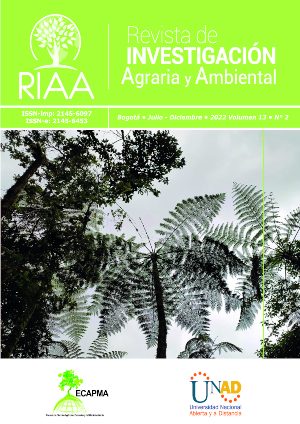Derechos de autor 2022 Revista de Investigación Agraria y Ambiental
 Cuando RIAA recibe la postulación de un original por parte de su autor, ya sea a través de correo electrónico o postal, considera que puede publicarse en formatos físicos y/o electrónicos y facilitar su inclusión en bases de datos, hemerotecas y demás sistemas y procesos de indexación. RIAA autoriza la reproducción y citación del material de la revista, siempre y cuando se indique de manera explícita el nombre de la revista, los autores, el título del artículo, volumen, número y páginas. Las ideas y conceptos expresados en los artículos son responsabilidad de los autores y en ningún caso reflejan las políticas institucionales de la UNAD
Cuando RIAA recibe la postulación de un original por parte de su autor, ya sea a través de correo electrónico o postal, considera que puede publicarse en formatos físicos y/o electrónicos y facilitar su inclusión en bases de datos, hemerotecas y demás sistemas y procesos de indexación. RIAA autoriza la reproducción y citación del material de la revista, siempre y cuando se indique de manera explícita el nombre de la revista, los autores, el título del artículo, volumen, número y páginas. Las ideas y conceptos expresados en los artículos son responsabilidad de los autores y en ningún caso reflejan las políticas institucionales de la UNAD
Identificación de aceites esenciales y parámetros productivos de Mentha spicata cultivada en sistemas acuapónicos y camas contenidas
Contextualización: Es de amplio conocimiento, el hecho que los sistemas de producción agrícola han estado en un proceso de mejora, para ser cada día más eficientes. Lo anterior con el objetivo de poder alcanzar la demanda básica de alimentos en un menor espacio. Los sistemas acuapónicos, permiten aumentar la producción de cultivos de interés comercial y nutricional, en una pequeña área, haciendo uso más racional de los recursos naturales• Vacío de conocimiento: En los sistemas acuapónicos, son pocos los estudios de aceites esenciales en plantas aromáticas, tanto a nivel nutricional como medicinal. Siendo la menta unos de los cultivos que presenta más potencial en la medicina alternativa por sus múltiples características bioactivas. • Propósito: El presente trabajo evaluó los metabolitos secundarios presentes en aceites esenciales de plantas de menta (M. spicata) de un sistema acuapónico con tilapia roja (Oreochromis sp.), en comparación con un cultivo en cama contenida. • Metodología: Se implementaron tres sistemas acuapónicos de 3m2 para siembra de plantas y la misma área en cultivos en cama contenida (9m2). Mensualmente se realizaron mediciones de crecimiento en las plantas y los peces. Semanalmente se midieron los parámetros de calidad de agua: NAT, nitrito, nitrato, fosfatos y pH. Al final del cultivo se realizó la extracción de aceites esenciales por el método de arrastre por vapor. Luego obtuvieron las matrices y se caracterizaron bajo un modelo de CG-MS comparando el área y tiempo de retención de los compuestos hallados en ambos cultivos. • Resultados y conclusiones: Las muestras extraídas de los sistemas acuapónicos presentaron una mayor diversidad de compuestos en comparación con las camas contenidas. El compuesto más abundante en ambos sistemas fue la menta-Furanona, siendo mayor en los sistemas acuapónicos. La menta creció considerablemente mejor en los SA presentando una mayor biomasa, número de tallos y parámetros productivos. Este trabajo demuestra que los sistemas acuapónicos presentan una mayor diversidad de compuestos y un mejor rendimiento que un cultivo tradicional en cama contenida.
Derechos de autor 2022 Revista de Investigación Agraria y Ambiental
 Cuando RIAA recibe la postulación de un original por parte de su autor, ya sea a través de correo electrónico o postal, considera que puede publicarse en formatos físicos y/o electrónicos y facilitar su inclusión en bases de datos, hemerotecas y demás sistemas y procesos de indexación. RIAA autoriza la reproducción y citación del material de la revista, siempre y cuando se indique de manera explícita el nombre de la revista, los autores, el título del artículo, volumen, número y páginas. Las ideas y conceptos expresados en los artículos son responsabilidad de los autores y en ningún caso reflejan las políticas institucionales de la UNAD
Cuando RIAA recibe la postulación de un original por parte de su autor, ya sea a través de correo electrónico o postal, considera que puede publicarse en formatos físicos y/o electrónicos y facilitar su inclusión en bases de datos, hemerotecas y demás sistemas y procesos de indexación. RIAA autoriza la reproducción y citación del material de la revista, siempre y cuando se indique de manera explícita el nombre de la revista, los autores, el título del artículo, volumen, número y páginas. Las ideas y conceptos expresados en los artículos son responsabilidad de los autores y en ningún caso reflejan las políticas institucionales de la UNAD








